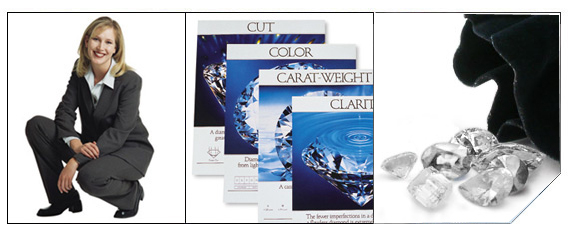DIAMOND FACTS | DIAMOND BUYING GUIDE
Diamond Color | Diamond Clarity | Diamond Weight | Diamond Cut| Diamond Fluoroscence | Diamond Certificates


Diamond Color: We think color is one is one of the most important factors to consider when selecting a diamond because it is one of the first things most people notice-whether or not the diamond is "white". It is also one of the most significant factors affecting value. Today, the color designation frequently used to grade an absolutely water clear, colorless diamond is the letter D. The GIA classification progresses from D, the finest classification on this scale (colorless), through the alphabet Z, getting progressively yellower.
D: Absolutely colorless. The clearest diamond color grade, which is very rare.
E: Extremely colorless. Trained gemologists can detect slight color. A high-quality diamond.
F: Colorless. Only trained gemologists can detect color. Lowest of the colorless grades.
G-H: Near-colorless. When compared to better color grades, slight color detectable, but is a much better value.
I-J: Near-colorless. Color slightly detectable. An excellent value.
K-M: Sndgems does not carry these color grades.

D, E, and F
can all be grouped as exceptionally fine and may be referred as
"colorless," "exceptionally white" or "rare
white". G and H may be referred to as "fine white" or
"rare white." These grades are considered very good. I and
J colors are slightly tinted white. K and L show a tint of yellow or brown.
What is fluorescence?
If the diamond you are considering is accompanied by a diamond
grading report, it will indicate whether the diamond has some degree
of fluorescence. This is a property that some stones posses which
causes them to appear a different color in some lights than in other
lights. A diamond that fluoresces might look white that it is really
in certain light. Related to diamond color, fluorescence is a unique
effect that causes a diamond to produce a slight blue glow when
exposed to intense, direct ultraviolet light. Some people seek
diamonds that produce this unique effect, while others definitely
want to avoid it — it's purely a matter of taste.
For the
purist, look for a colorless diamond with a grade of D-F and a
fluorescence rating of none, faint, or slight.
For an
excellent value in a diamond with no noticeable color to the unaided
eye, look for a near-colorless grade of G-I, and a fluorescence grade
of medium or strong blue.
Or, if you'd rather not compromise on color but would like to stay on budget, choose a diamond with a good cut and SI1–SI2 clarity and consider going with a strong fluorescence. It will still be beautiful to the unaided eye and you may prefer the unique effect of a strong fluorescence.

